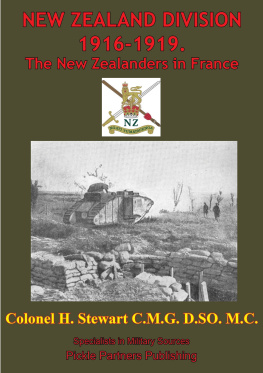A project of this magnitude would not have been possible without the generous assistance of a large number of individuals and organizations those who spared us the time to help in our quest to locate the War Diary entry of each and every battalion that went over the top on 1 July 1916. Unfortunately, with so many transcriptions, it is not possible to thank each and every one of those historians, library services, regimental museums and county record offices or archives by name. To you all, though, we extend our grateful thanks.
We are also grateful to Jon Cooksey, editor of Stand To! , the journal of the Western Front Association, not only for agreeing to write a Foreword, but also for his assistance in compiling our list of those battalions to be included.
Lastly, without the untiring help of Sara Mitchell, both in the initial research and in the subsequent transcriptions, we doubt that this book would ever have seen the light of day.
VII Corps
1 July 1916
P art of Sir Douglas Haigs plan was to lengthen the front of attack by a subsidiary offensive against Gommecourt. For this he had renounced the idea of recapturing the portion of Vimy ridge lost on 21 May, having decided that, with the troops available, he had not sufficient forces to undertake both enterprises. The operation against Gommecourt was allotted to VII Corps of the Third Army (General Sir Edmund Allenby). Between it and the left of the main attack against Beaumont Hamel and Serre, carried out by VIII Corps, there would be left a two mile gap, from which no attack was to be made owing to lack of troops. This, as we have seen, was held by two battalions provided by VIII Corps.
It was not until 28 April that General Snow had received orders that an offensive against Gommecourt would be required at the end of May, a date subsequently postponed to the end of June. During the first week in May the 56th and 46th Divisions arrived in VII Corps area to carry out the operation. By the morning of the 10th they had taken over the trenches allotted to them, part of a very wide front hitherto held by the 37th Division, which then closed on its left. It was, however, asking very much that two divisions new to the ground should attack at two months notice defences of the strength of Gommecourt, unless a complete surprise without much previous preparation were intended. The enemy salient was in reality a small modern fortress. It required siege operations, or, at any rate as events proved, bombardment by super-heavy guns to destroy its dug-outs, as well as a great amount of trench-work to get within assaulting distance, besides an ample supply of labour for carrying up stores and munitions. For mining there was obviously no time. It must, however, be distinctly borne in mind that in Sir Douglas Haigs plan nothing depended on the capture of Gommecourt.
The object of the attack was to assist in the operations of the Fourth Army by diverting against itself the fire of artillery and infantry which might otherwise be directed against the left flank of the main attack near Serre. There was no intention of exploiting the capture of Gommecourt by sending a force southwards from the village to roll up the German line or clear the ridge leading south-east behind it. No troops were provided or available for such a purpose. A success at Gommecourt would merely shorten the British line by cutting off an enemy salient.
It seems improbable that GHQ realized the strength and that strength enormously increased by flanking artillery defence of the Gommecourt salient. If an attack is to be made merely in order to hold enemy troops and prevent their employment elsewhere, a weak or vulnerable part of the enemys front should be chosen, not the strongest. Further, Gommecourt was particularly easy of defence, and from the shape of the ground it was a most difficult place from which to disengage troops in the event of partial failure or incomplete success.
Neither General Snow of VII Corps nor his Army commander were men of half measures. If the enemys attention was to be attracted to Gommecourt in order to ensure the success of the Fourth Army, they were ready to take all risks, but they did go to the length of suggesting that a threat from Arras would be more effective and less costly. This, however, would not have prevented the enemy from using the guns which he had in the vicinity of Gommecourt against the northern flank of VIII Corps.
Sir Douglas Haig having decided in favour of the attack on Gommecourt, the divisions of VII Corps were at once set to work on preparations and training on the same lines as those of the Fourth Army. Ill luck seemed to attend on the preparations, and it seemed an evil presage to the troops that an enemy aeroplane at once flew over the practice ground marked out to represent unmistakeably the Gommecourt defences. Lack of sufficient labour units necessitated the employment of all the attacking battalions of the 46th Division and many of those of the 56th, whose sector was not so water-soaked, in the most exacting fatigues up to the very eve of the assault. Probably barely a man of the former division enjoyed a full nights sleep for a week previous to the attack, and there was scarcely a day or night when the rain did not fall consistently and heavily, and working parties were not soaked to the skin.
The ground had an important bearing on events. Gommecourt village stands at the junction of four low ridges with flat tops, which make the outline of a St. Andrews Cross, its four arms stretching towards Essarts, Rossignol Wood, the western edge of Hbuterne, and the eastern edge of Fonquevillers. The German line on the north-western face of the salient ran slightly below the crest of the western side of the Essarts ridge, with a shallow valley in front of it, on the other side of which was the British line.
Behind this line the ground was nearly level, so that the Germans had complete observation for more than 2,000 yards over VII Corps area (except over a small portion hidden by the ruins of Fonquevillers and the trees near that village) and the 46th Division had in consequence to dig numerous long and deep communication trenches. On the south-western face of the salient, almost as far south as Nameless Farm, the British and German trenches were nearly on the same level, with a dip, in which there was a hedge, between them; beyond this point both were on the western side of the wide valley between Rossignol Wood and Hbuterne, the British thus being on a forward and the Germans on a reverse slope. The enemy artillery observation posts were on the eastern side of the valley. The approaches on the British side in the 56th Division area were completely hidden from ground view right up to Hbuterne, but were under observation of the German balloons. The chief British observation posts were on the eastern edge of this village and the ridge running south of it. The slope of the valley provided natural drainage, which the very gentle gradients in the 46th Division sector did not.
The defences of Gommecourt were, in consequence of their salient position and a previous unsuccessful French attack on them, stronger probably than any others on the German front, and were specially well provided with deep dugouts,
As finally settled, the plan for the capture of the Gommecourt salient consisted of two convergent attacks against its haunches (first objective). These secured, the attackers were to proceed and join hands in the German 1st Switch Line behind the village, and thus isolate it. The programme gave the infantry thirty minutes from zero to reach this second objective. On the 2,000 yards of front facing the village and park, between the two attacks, there were to be no offensive operations, but wire was to be cut and smoke released as elsewhere. The clearing of the park, the village and the Maze was not to be attempted before zero plus three hours, until which time the fire of the super-heavy and heavy howitzers was to be kept on these targets. There was not sufficient time to undertake mining operations, as No Mans Land was wide, and silent mining under the German trenches was impossible except at fifty or sixty feet, a depth which would much delay the removal of spoil. This was a most unfortunate circumstance, for the explosion of a large charge against the warren of deep dug-outs in Gommecourt Park, or under the Maze, might have proved a determining factor in the action.



















